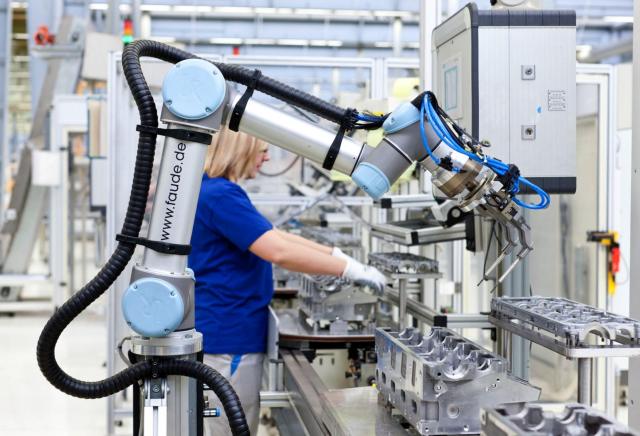Credit: Thomas Gasparini/VW/DPA/PA Images

By the end of the next decade, 89.3% of all articles about robots taking our jobs will be written by robots. This is a FACT – or at least it might be if it were based in any sort of reality.
The trouble with the future is that hasn’t happened yet and therefore isn’t real. That’s worth bearing in mind when you read scary predictions about the impact of automation and artificial intelligence on the employment of human beings.
Having featured a number of predictions at the scarier end of the spectrum, it’s time that this column unpacked an argument from the other end. In an essay for Wired, James Surowiecki – author of the Wisdom of Crowds – insists that the robot ‘jobocalypse’ is not nigh:
“If automation were, in fact, transforming the US economy, two things would be true: Aggregate productivity would be rising sharply, and jobs would be harder to come by than in the past…”
“Yet, in reality, productivity gains over the past decade have been, by historical standards, dismally low. Back in the heyday of the US economy, from 1947 to 1973, labor productivity grew at an average pace of nearly 3 percent a year. Since 2007, it has grown at a rate of around 1.2 percent, the slowest pace in any period since World War II. And over the past two years, productivity has grown at a mere 0.6 percent—the very years when anxiety about automation has spiked…”
And as for the availability of jobs…
“Unemployment is below 5 percent, and employers in many states are complaining about labor shortages, not labor surpluses… Granted, the wage increases are meager by historical standards, but they’re rising faster than inflation and faster than productivity.”
I’ll come back to the mystery of the missing productivity, but the lack of mass unemployment can be easily explained. Automation (together with globalisation) makes a number of goods (and information-based services) much cheaper to produce. Competition drives prices down and consumers spend what they save on something else, thereby generating demand – and jobs – elsewhere.
It also helps that technology has, so far, automated certain tasks within particular occupations, as opposed to the occupation as a whole:
“Of the 271 occupations listed on the 1950 census only one—elevator operator—had been rendered obsolete by automation by 2010.”
However, with continuing technological progress, there’s no guarantee that the other 270 are permanently safe. And even before we get to full automation of an occupation, semi-automation can greatly reduce the number of people required to do it. For instance, Tesla has unveiled an electric, semi-automated truck that can be driven in convoy, with a human driver required only for the lead vehicle.
But that brings us back to the productivity puzzle. If machines are taking over the most routine parts of our jobs, why aren’t we becoming more productive? Or, if we are becoming more productive, won’t continued automation lead to such a bountiful economy that we’ll have nothing to worry about?
This is James Surowiecki’s most important argument:
“The peculiar thing about this historical moment is that we’re afraid of two contradictory futures at once. On the one hand, we’re told that robots are coming for our jobs and that their superior productivity will transform industry after industry. If that happens, economic growth will soar and society as a whole will be vastly richer than it is today. But at the same time, we’re told that we’re in an era of secular stagnation, stuck with an economy that’s doomed to slow growth and stagnant wages… Both of these futures are possible. But they can’t both come true. Fretting about both the rise of the robots and about secular stagnation doesn’t make any sense. Yet that’s precisely what many intelligent people are doing.”
Unfortunately, there is a way of reconciling the automation of jobs with stagnating productivity and low growth. If certain goods and services can be produced at such low cost that they become free or at least extremely cheap, then they effectively disappear from the measured economy – contributing no more, or little more, to GDP (and therefore productivity) than do fresh air and sunshine.
Free/cheap stuff is nice to have, of course. But, within each product category, there comes a point when you don’t need or want any more – e.g. there’s only so much food you can sensibly eat or information you can usefully access.
Over the long-term, automation may well destroy most jobs, but it can only continue to make us richer if it boosts production of what remains in short supply.










Join the discussion
Join like minded readers that support our journalism by becoming a paid subscriber
To join the discussion in the comments, become a paid subscriber.
Join like minded readers that support our journalism, read unlimited articles and enjoy other subscriber-only benefits.
Subscribe